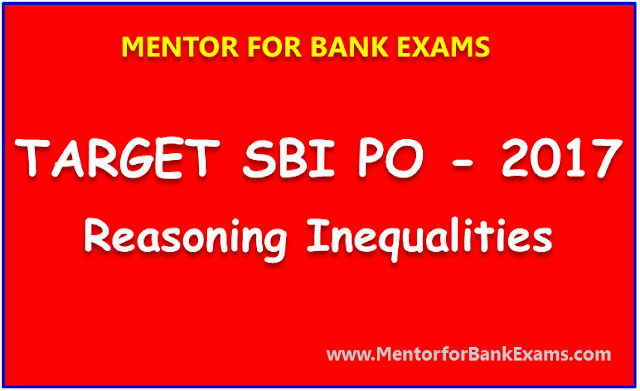REASONING INEQUALITIES
What are Inequality Based
Questions?
In these questions, you will be
provided with a statement consisting of a group of elements. These elements
will be having a certain coded relationship among them which is denoted by
different inequality symbols like >, <, = etc.
You should know the meaning of
different symbols which will help you in finding the relationship between the
different elements of a statement.
For the sake of convenience, the
relationship between certain statements and their meaning is given below in a
tabular form.
S.No
|
Symbol
|
Meaning
|
1.
|
A
> B
|
A
is Greater than B.
|
2.
|
A
< B
|
A
is Smaller than B
|
3.
|
A =
B
|
A
is Equals to B.
|
4.
|
A ≠
B
|
A
is either greater than or smaller than B
|
5.
|
A
≥ B
|
A
is Greater than or Equals to B
|
6.
|
A ≤
B
|
A
is Smaller than or Equals to B
|
The table given above shows the six
symbols on which the entire inequality is based. But in exam, you will find a
statement that will have a relationship between more than 2 elements.
Let us take some patterns likely to
be asked in the exam
S.No
|
Statement
|
Conclusion
|
1.
|
P>Q>R
|
P>R
|
2.
|
P>Q≥R
|
|
3.
|
P≥Q>R
|
|
4.
|
P=Q>R
|
|
5.
|
P>Q=R
|
|
6.
|
P<Q<R
|
P<R
|
7.
|
P<Q≤R
|
|
8.
|
P≤Q<R
|
|
9.
|
P=Q<R
|
|
10.
|
P<Q=R
|
|
11.
|
P≥Q≥R
|
P>R
or P=R
|
12.
|
P=Q≥R
|
|
13.
|
P≥Q=R
|
|
14.
|
P≤Q≤R
|
P<R
or P=R
|
15.
|
P=Q≤R
|
|
16.
|
P≤Q=R
|
|
17.
|
P<Q>R
|
No
conclusion can be inferred
|
18.
|
P≤Q>R
|
|
19.
|
P<Q≥R
|
|
20.
|
P>Q<R
|
|
21.
|
P>Q≤R
|
|
22.
|
P≥Q<R
|
If you understand the above rules,
you will be able to attempt all the questions asked in the exam
Types of Questions asked
in Inequality
Now a days, inequality based
questions are provided in two types
- Direct
Inequality in which direct symbols will be given in the statement.
- Coded
Inequality in which coded symbols (like @, %, $ etc) will be given and
they signify will be provided separately.
Both kinds of questions can be solved
easily once you have gone through the above tables.
Example:
In the following question, the
symbols (*, $, #, % and @) are used with the following meanings as illustrated
below:
- ‘X%Y’
means ‘X’ is greater than ‘Y’.
- ‘X#Y’
means ‘X’ is smaller than ‘Y’.
- ‘X$Y’
means ‘X’ is either greater than or equal ‘Y’.
- ‘X*Y’
means ‘X’ is either smaller than or equal to ‘Y’.
‘X@Y’ means ‘X’ is equal to ‘Y’.
A) If only conclusion I is true.
B) If only conclusion II is true.
C) If either conclusion I or II is
true.
D) If neither conclusion I nor II is
true.
E) If both conclusions I and II are
true
Statement: P * Q, Q#R, R*S
Conclusions:
I. P # S
II. Q*S
Answer: A
Explanation:
P ≤ Q < R ≤ S.
Hence, P< S which implies
Conclusion I is true.
As Q< S which implies conclusion
II is not true
Tips and Tricks to solve
Inequality based question:
You should keep in mind the priority
order while solving these type questions
- Priority
1: < or >
- Priority
2: ≥ or ≤
- Priority
3: =
Trick 1: Whenever in a statement you get both the priority 1 in opposite order
(A>B<C) there will be a conflict and thus no conclusion.
If A > B <C Then A < C =
False & C > A = False.
But
If A > B >C then A > C =
True, C < A = True
Example:
- Statement:
A < D > C < E > B
- Conclusions:
1) C > B → False
2) A < E → False
3) D > B →
False
In simple way, whenever these two
sign comes in opposite direction the answer will be false.
Trick 2: Whenever in a statement you get both
the priority 2 in opposite order (A≥ B ≤C) there will be a conflict and thus no
conclusion.
If A ≥ B ≤C Then A ≤ C = False &
C ≥ A = False.
But
If A ≥ B ≥ C then A ≥ C = True, C ≤ A
= True.
Example:
- Statement:
B ≥ D ≤ A ≥ F ≤ C
- Conclusions:
1) A ≥ C → False
2) B ≤ F → False
3) D ≥ C → False
Trick 3: When
it occurs to you that the statement of order is opposite just change the sign
in the alternate direction
If A > B > C > D < E <
F
We can say that A > B > F = C
< B < A
This was all about tips and tricks to
solve Inequality based questions. So try the above tips and tricks on the
Inequality based questions.
Download the 200
Inequalities Questions PDF Here






